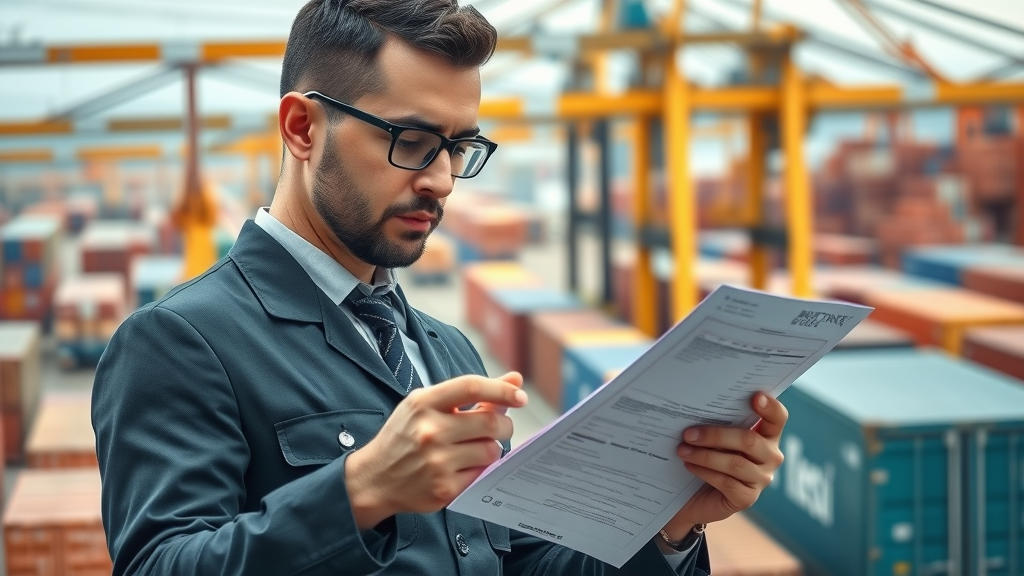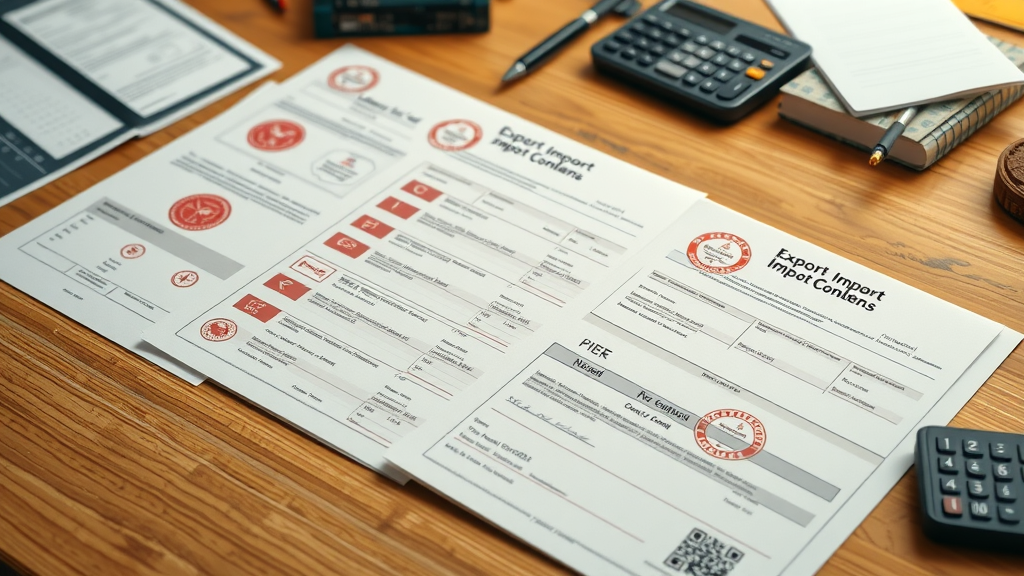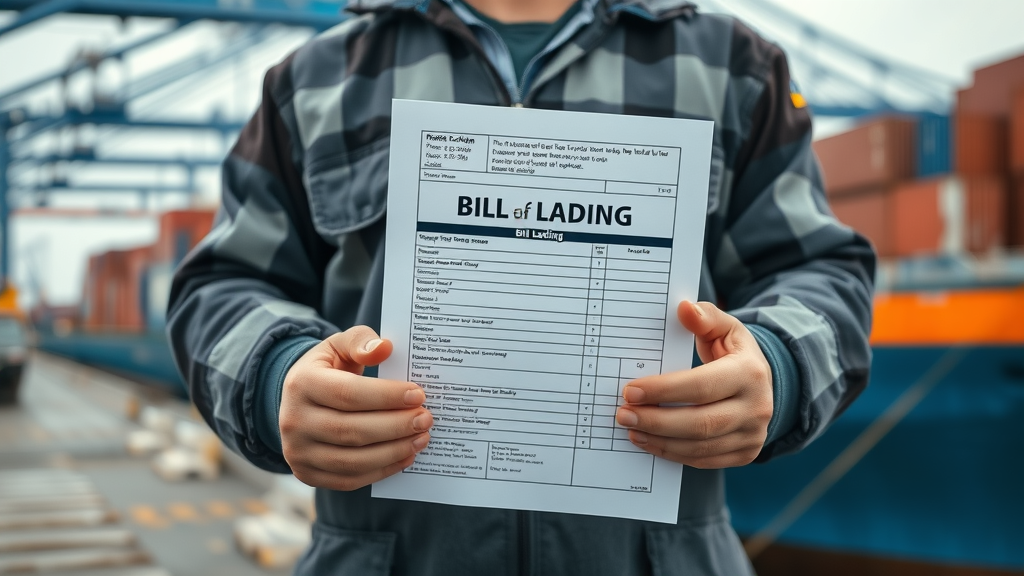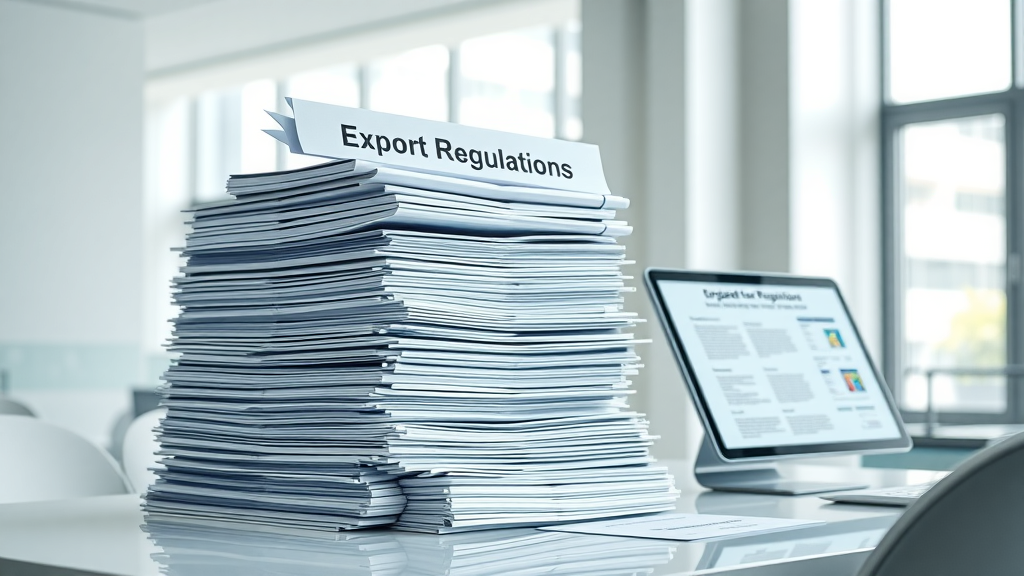Did you know that more than 70% of global shipping delays are caused by documentation errors? In today’s fast-paced world of international trade, a single mistake on crucial export documents can halt your entire supply chain, drain revenue, and frustrate business partners. Whether you’re a seasoned exporter or just starting, getting your import export documentation right is not a luxury—it’s essential for seamless customs clearance and business growth. This comprehensive guide will help you conquer the paperwork, ensure compliance, and safeguard your shipments against costly setbacks.

Why Import Export Documentation Matters: Key Reasons and Surprising Statistics
The Crucial Role of Import Export Documentation in International Trade
At the heart of every international trade transaction lies rigorous import export documentation . These shipping documents are much more than mere paperwork—they are the legal backbone of every cross-border deal. Well-prepared export documents unlock smooth customs clearance, minimize disputes, and enable access to global markets. From establishing ownership to verifying product authenticity, these documents ensure that goods move efficiently while staying compliant with local and international regulations. Customs officials in every country rely on this documentation to assess duties, verify trade agreements, and prevent illegal shipments. Without meticulous documentation, even the most robust supply chains face breakdowns, delays, and fines—hindering both small businesses and export giants alike.
The tightening web of regulation across borders makes flawless implementation even more vital. Whether shipping from the United States, Europe, or Asia, authorities increasingly demand accuracy, traceability, and transparency. The instructions provided by a shipping document such as a bill of lading or an air waybill dictate how goods move from origin to destination. Consequently, mastering import and export document requirements positions your business for operational agility and uninterrupted cash flow.
Startling Fact: Over 70% of Global Shipping Delays are Linked to Documentation Errors
Recent industry studies reveal that over 70% of shipping delays worldwide are directly tied to errors in import export documentation . The consequences are staggering—billions of dollars lost annually due to improper product descriptions, outdated export licenses, or missing signatures on a bill of lading. These mistakes ripple through the supply chain, increasing demurrage charges, halting customs clearance, and derailing delivery timelines. Even minor discrepancies between shipping documents such as the packing list and the commercial invoice can raise red flags during inspection, incurring extra scrutiny from customs officials.
Given the increasing digitization of trade processes, even automated systems depend on consistent, accurate data entry. An incorrect HS code on a certificate of origin, or a mismatched value in a pro forma invoice, can be the difference between a swift border crossing and a week-long warehouse hold. In short, effective documentation is not just a task for compliance—it’s the key to protecting your brand, customer relationships, and bottom line.
Achieve Seamless Customs Clearance with Accurate Import Export Documentation

How Import Export Documentation Impacts Customs Clearance and Compliance
Accurate import export documentation is the gateway to fast-tracked customs clearance . Each export document—from the humble commercial invoice to the highly detailed bill of lading—serves a critical function in demonstrating ownership, value, country of origin, and regulatory compliance. Customs authorities scrutinize these documents to assess duties and taxes, verify eligibility under free trade agreements, and enforce trade regulations. Any error or omission can trigger inspections, seizures, or even penalties, putting your goods and profits at risk.
Quote: “Customs clearance delays cost global businesses billions annually—a single document oversight can stall entire supply chains.”
By adopting a proactive approach to your export and import documentation, you not only safeguard your business from costly hold-ups but also build credibility with trading partners. Engaging with a reliable freight forwarder and regularly updating your compliance processes are just two strategies that streamline documentation for both sea and air shipments. When all shipping documents are aligned and errors are eliminated, your shipments move seamlessly through each stage of global logistics—from warehouse to final delivery.
What You’ll Gain from Mastering Import Export Documentation
- Step-by-step breakdown of required export documents and import export documentation
- Expert tips to prevent mistakes in your shipping documents
- Visual tables and lists for fast reference
- Answers to common documentation questions
- Best practices for maintaining proactive compliance

Core Import and Export Documents Explained
Commercial Invoice: The Backbone of Import Export Documentation
The commercial invoice is the primary export document in any international trade transaction. It acts as a detailed bill for the transaction, listing the buyer and seller, full product descriptions, prices, payment terms, and other critical details. Customs authorities depend on the commercial invoice to calculate import duties and verify the legitimacy of each shipment. For both exports and imports, consistency between this invoice and other documentation like packing lists and bills of lading is paramount to avoid compliance issues. Errors such as non-matching values or lack of buyer identification can result in rejected shipments or delayed customs clearance.
Modern commercial invoices also often include precise Harmonized System (HS) codes, which streamline the classification of goods across international borders. When compiling this export document, ensure every field is completed accurately, and check regularly for changes in local customs requirements, especially if shipping from or to the United States, European Union, or major trade partners. Ensuring clarity on your commercial invoice helps customs officials quickly process your shipments and minimizes the likelihood of unexpected questions or holds.
Pro Forma Invoice: Setting Clear International Trade Expectations
A pro forma invoice is issued before the shipment of goods and acts as a quotation or offer to the buyer. It's a foundational export document, serving as the starting point for customs clearance procedures and financial arrangements. For many importers, especially those new to international trade, the pro forma invoice works as a price reference and order confirmation—helping overseas buyers arrange for a letter of credit or even import licenses as needed. This form also lays out trade agreement details, shipping terms, and the estimated value and volume of the intended shipment.
While not a substitute for a commercial invoice, the pro forma invoice ensures all parties share the same expectations, reducing risks of miscommunication or order dispute down the line. Regularly updating and aligning your pro forma invoice with the latest trade regulations is vital, particularly if dealing with restricted or high-value products.
Bill of Lading and Ocean Bill of Lading: The Shipping Document for Every Export
The bill of lading (B/L) is one of the most important shipping documents, acting both as a receipt for the goods shipped and as legal title to those goods. Without a properly executed bill of lading or its ocean-specific variant—called the ocean bill of lading —customs clearance for sea freight simply cannot proceed. This document details shipping routes, identifies shipper and consignee, and can be endorsed or transferred, making it key to international trade finance (especially with letters of credit).
All bills of lading must be checked thoroughly for accuracy, including the container details, vessel information, and descriptions consistent with both the packing list and commercial invoice. Missing signatures or mismatched data between paperwork can halt cargo release at destination ports. For every international shipment—especially with high-volume or consolidated cargo—prioritize the bill of lading for audit and error-checking before dispatch.

Air Waybill: Essential for Air Freight Shipments
An air waybill (AWB) is the shipping document specific to international air freight. Unlike a bill of lading, it is not a negotiable instrument but serves as both a contract of carriage and proof of receipt. Airlines and freight forwarders issue the AWB, listing essential shipping details, recipient and sender addresses, and any special cargo handling instructions. For import and export shipments via air, customs authorities use this document as a primary reference during clearance. Incomplete or inaccurate information can result in flight delays, cargo detention, or regulatory fines—making the accuracy of each air waybill just as critical as with other shipping documents.
Consistency with the commercial invoice, export packing list, and insurance certificate ensures that air shipments glide smoothly through international gateways. With the boom of e-commerce and express shipments, a digitally managed air waybill system has become standard practice among global exporters.
Packing List: Ensuring End-to-End Consistency in Shipping Documentation
The packing list clearly itemizes all goods, quantities, weights, and packaging types within an international shipment. More than a reference for the shipper or freight forwarder, customs officials rely on the packing list to verify that invoice values match physical contents. If any discrepancy exists between the packing list, commercial invoice, and shipping document such as a bill of lading, you risk shipment holds or customs inspection. This document should be as detailed as possible, including package marks, handling instructions, and cross-references to container numbers or bills of lading.
A well-organized packing list simplifies international shipping for all parties—especially if cargo is split across multiple containers or destinations. Ensure that all relevant data is digitally logged and double-checked before dispatch, particularly under today’s heightened scrutiny from customs authorities worldwide.
Certificate of Origin: Proving Product Legitimacy for Customs Clearance
The certificate of origin is a vital document proving the country of manufacture or processing for exported goods. This form is often required to qualify for reduced tariffs under a free trade agreement or to comply with specific import requirements in certain countries. Chambers of commerce typically issue and authenticate certificates of origin, which customs officials then use to validate claims and enforce trade policy.
Errors in the certificate of origin—such as misdeclared country or illegible stamps—can delay customs clearance or disqualify goods from preferential trade benefits. For businesses engaged in complex international supply chains, maintaining robust records and updated knowledge of destination country rules is a must. A valid and accurate certificate of origin is also essential for gaining trust with international buyers and governmental agencies alike.
Insurance Certificate: Protecting Your International Trade Shipments
The insurance certificate documents that your shipment is covered against loss or damage in transit. Most import and export contracts stipulate some form of insurance—especially for high-value or bulk shipments. Customs authorities, buyers, and banks often require this certificate before clearing or releasing goods, particularly in trade where risk management is legally mandated.
The insurance certificate should clearly reference the shipment, carrier, and terms outlined in other export documents. When accurately completed and available, this document prevents costly disputes after delivery and safeguards both exporter and importer against unforeseen incidents at sea, in the air, or en route by land.
Export License: When Regulatory Approval is Mandatory
Some goods require an export license before they can legally leave the country of origin. This includes controlled technologies, dual-use products, firearms, pharmaceuticals, and other regulated categories. Export licenses are typically issued by specific government agencies and must be cross-referenced with shipping documents, commercial invoices, and the bill of lading. Failure to secure a required export license is a severe violation—resulting in penalties, shipment seizure, or even prosecution.
Check current regulatory requirements for each product and destination, as rules change frequently. A proactive documentation strategy—updating licenses, verifying expiry dates, and matching product codes—ensures that your international shipments never run afoul of the authorities.
| Document | Purpose | Required For | Issuing Authority |
|---|---|---|---|
| Commercial Invoice | Proof of Sale & Value | All Shipments | Shipper |
| Pro Forma Invoice | Quotation/Offer | Before Shipment | Shipper |
| Bill of Lading | Title & Receipt | Sea Shipments | Carrier |
| Air Waybill | Title for Air Cargo | Air Shipments | Carrier |
| Packing List | Contents Declaration | All Shipments | Shipper |
| Certificate of Origin | Origin Validation | Many Shipments | Chamber of Commerce |
| Insurance Certificate | Cargo Insurance | Upon Value | Insurer |
| Export License | Regulatory Control | Restricted Goods | Govt. Agency |
Step-by-Step Guide: How to Prepare Import Export Documentation for Seamless Processes
Gathering Key Shipping and Export Documents
The preparation of shipping documents should follow a structured checklist to minimize errors. Start by collecting all core export documents: commercial invoice, pro forma invoice, bill of lading (or air waybill), packing list, insurance certificate, certificate of origin, and any required export license. Confirm that every detail—names, addresses, product specs, and values—is accurate and consistent across all forms. Good communication with your freight forwarder can help track down missing paperwork, clarify document requests, or resolve inconsistencies before goods depart the warehouse.
Involving your customs broker or compliance department from the outset streamlines the documentation workflow and guards against regulatory surprises. Keep digital backups of all records and use document management systems to simplify updates and audits for repeated export and import transactions. This approach enables quick compliance checks when facing new trade destinations or heightened border scrutiny.

Verifying Details for Compliance: Names, Values, Descriptions, and Codes
Checking every field on your import export documentation can mean the difference between flawless customs clearance and revenue-draining delays. Confirm consistency in key details such as names of shipper and consignee, descriptions, quantities, unit values, and Harmonized System (HS) codes. Reviewing customs requirements for your target country—whether it’s the United States, European Union, or Asia-Pacific—is essential, as acceptance criteria or local rules can change yearly. Any discrepancy between the shipping document, packing list, and commercial invoice can trigger a customs inspection, causing shipment holds or financial penalties.
It’s advisable to run a pre-shipment compliance audit using automated tools or third-party services, especially for high-value or complex international trade. Proactively updating templates and checklists as regulations evolve ensures seamless processes for both repeat and new transactions. Train your team to spot red flags like outdated export licenses, wrong destination addresses, or missing certificates of origin.
Coordinating with Freight Forwarders for Customs Clearance
Partnering closely with freight forwarders streamlines the customs clearance process. These logistics professionals ensure your export and import documentation is complete and correctly sequenced before cargo departure. Discuss every stage: pick-up, warehousing, export packing, document submission, and final delivery. Freight forwarders often coordinate directly with customs officials to resolve discrepancies or provide supplementary documents if required. Their expertise in both ocean and air shipment requirements helps you avoid mistakes across all transport modes.
Set up clear lines of communication—including digital tracking and regular check-ins—to anticipate any evolving customs rules or special requirements for restricted goods. Reliable freight forwarders not only provide guidance but also help you leverage technology to monitor document flow, ensuring nothing is overlooked along the supply chain.

Double-Checking Packing List and Shipping Documents for Accuracy
The final stage before shipment dispatch is to meticulously review your packing list, commercial invoice, and other shipping documents for any inconsistencies. Reconcile item counts, product weights, and HS codes, ensuring that everything matches from the pro forma invoice to the bill of lading or air waybill. Keep an eye out for common errors: missing package details, unclear product descriptions, or unsigned documents.
Using a pre-departure checklist, verified by both your logistics team and customs broker, ensures your goods won’t hit unnecessary snags at border controls. Double-checking all paperwork is especially crucial for shipments involving multiple containers, split deliveries, or international consolidation, where mistakes can easily slip through. Promptly address any discrepancies, update forms, and secure all necessary stamps and signatures before presenting documents to customs authorities.
Common Mistakes in Import Export Documentation—and How to Avoid Them

- Incorrect product descriptions or HS codes in shipping documents
- Missing signatures or stamps on bill of lading/ocean bill of lading
- Discrepancies between packing list, commercial invoice, and pro forma invoice
- Lack of required certificates for specific international trade destinations
- Invalid or outdated export licenses
Expert Tips to Safeguard Your Import and Export Success
To fortify your import and export processes, implement routine documentation audits and keep checklists up to date. Stay informed on international trade regulation changes by subscribing to updates from customs agencies and chambers of commerce. Designate a compliance lead within your team to oversee the entire documentation flow, spot risks, and deliver targeted training on how to avoid frequent pitfalls outlined above. Collaboration with experienced freight forwarders and customs brokers ensures your export documents meet destination-specific regulations and minimize the chance of shipment delays or penalties.
Quote: “A proactive documentation checklist can accelerate customs clearance and prevent revenue loss.”
Utilize digital solutions—such as automated document management or tracking cloud-based export packing and shipping records—for scalable accuracy as trade volumes grow. Ultimately, attention to detail, training, and ongoing vigilance are the best defenses against the costly impact of documentation errors.
Import Export Documentation FAQs
- How are customs clearance requirements changing in 2024 for import and export? In 2024, customs authorities are placing more emphasis on digital documentation, traceability, and HS code accuracy. Rules for free trade agreements and export license updates are evolving quickly. Regularly review your government's customs agency website or subscribe to update bulletins to avoid falling behind.
- Which export document is mandatory for every country? The commercial invoice is universally required as proof of sale and value for almost all international shipments. However, most destinations also require a bill of lading or air waybill and packing list alongside the commercial invoice for successful customs clearance.
- How does an air waybill differ from an ocean bill of lading in international trade? An air waybill is used exclusively for air shipments and is not a negotiable instrument, while an ocean bill of lading acts as both receipt and title for sea cargo and can be transferred or endorsed. Both function as primary shipping documents but serve different transport modes and legal contexts.
People Also Ask: What are the export and import documents?
Export and import documents include commercial invoice, pro forma invoice, bill of lading, air waybill, packing list, insurance certificate, certificate of origin, and any required export license. Each is vital for proper customs clearance and shipping documentation.
People Also Ask: What documents are required for import?
Documents needed for import commonly include the commercial invoice, bill of lading or air waybill, packing list, certificate of origin, and insurance certificate. Depending on the goods and destination, specialized certificates and an import declaration may also be mandatory.
People Also Ask: What is an import and export declaration?
An import and export declaration is a formal statement provided to customs authorities with details of goods entering or leaving a country. This shipping document ensures compliance with international trade regulations and accurate customs clearance.
People Also Ask: What are the 5 steps of the export process?
The main steps include: 1) Quoting with a pro forma invoice, 2) Confirming order and drafting commercial invoice, 3) Arranging shipping and preparing bills of lading/air waybill, 4) Compiling all export documents and certificates, 5) Managing customs clearance and delivery.
Essential Resources for Staying Current with Import Export Documentation Requirements
- Links to government trade and customs agencies
- Templates for major shipping documents
- Latest updates for international trade rules in 2024

Stay Ahead in Global Trade: Elevate Your Import Export Documentation Practices
Have insights to share on global trade? Let's talk—call us at 203-271-7991 to explore contributing an article.
Ready to accelerate your global trade operations? Put these documentation best practices into action and never miss a customs clearance again.
To enhance your understanding of import and export documentation, consider exploring the following resources:
-
Common Export Documents : This resource provides a comprehensive overview of essential export documents, including pro forma invoices, commercial invoices, and packing lists, detailing their purposes and the information they should contain. ( trade.gov )
-
Essential Import/Export Documentation for International Trade : This article outlines key components of import/export documentation, such as commercial invoices, packing lists, and bills of lading, explaining their roles in ensuring compliance with legal requirements during international trade. ( lawhub.blog )
These resources offer valuable insights into the critical documents required for successful international trade operations.
 Add Row
Add Row  Add
Add 




Write A Comment